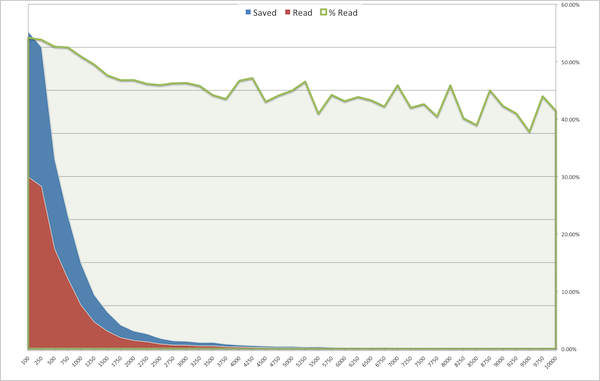
In this week’s Monday Note, Frédéric Filloux wrote a piece on the ecosystem of “smart people curat[ing] long form journalism,” which he described as including Longreads, Longform, and Instapaper.
Which, if you think about it, is an interesting grouping. Longform and Longreads are both curators of excellent, long works of journalism and nonfiction; they identify long stories and link to them. They’re fundamentally editorial products. Instapaper (along with its competitor Read It Later) is a tool, a method for saying, “I don’t want to read this now — so save this article in a pleasing format offline, in a place where I can come back to it later.” It’s a technical product; it deals with raw gibberish and finely honed prose equally well.
Instapaper-like tools and Longreads-like services get lumped together a lot because, I’d argue, of a story we like to tell ourselves about long-form journalism, something I like to call the Long-Form Longing. People who care about journalism — particularly those of us who’ve shifted 95-percent-plus of our reading online — love to valorize long-form journalism. We root for efforts that seem to promote the kind of work we fear might be getting lost in a blizzard of tweets. Here’s one of my favorite short pieces by Internet superstar and ex-Harper’s editor Paul Ford:
I was out for a drink with a friend who works for a womens’ magazine. She does not love her job, mostly because she is in charge of compiling yoga recipes and candle news (a column called Candletips) for the front of the book. “I just commissioned a 2,200-word piece,” she said, “with the provisional title Hollywood’s Neti Nuts: Star Sinus Secrets.” She took a long draught of red wine and closed her eyes for a moment. “So, that. But if you look in the back of the book, we are still publishing long-form journalism.”
That was not the first time I’ve heard this argument. Long-form journalism can be an excuse for just about anything. You might work for Teen Violence Week, and your job might require compiling a photo collage of the week’s best dick punches, but you can still feel proud that your magazine publishes 5,000 words about a Los Angeles clinic that performs free abortions for tapirs, or a serious investigation into America’s declining sandpaper standards (True Grit: The death of smooth).
The popularity of tools like Instapaper and Read It Later give us comfort — because if people are using them to read things later, it stands to reason that those things must be the kind of long-form work that we admire.
The thing is: that comforting vision doesn’t seem to be particularly true.
Remember last week when Read It Later released that great dataset on which publications and authors were saved the most often in its system? We wrote about it and, like others, noted that the most-saved authors often worked at blogs like Lifehacker, Gizmodo, Mashable, and Techcrunch. Fine publications all, but John McPhee they ain’t. This seemed to surprise Filloux:
Great writers indeed, but hardly long form journalism. We would have expected a predominance of long feature stories, we get columnists and tech writers instead.
“We would have expected” is the Long-Form Longing in a nutshell — the idea that, now that we have the tools to shift reading from length-averse environments (sitting at your desk at 10:30 a.m., avoiding an Excel spreadsheet) to length-friendly environments (on your couch, sipping merlot, iPad in hand), people will want 8,000 words on the history of grains. Or at least a long New Yorker feature. But the data doesn’t, at first glance, seem to back that up.
Here’s another, more thorough dataset that illustrates the point even better. Back in September, I moderated a panel on new platforms for long-form journalism. I wanted to have some new data for the introduction, so I emailed the nice folks at Read It Later to see if they could share with me the range of word counts of articles saved using its tool. How many were short quick blog posts, and how many were Vollmanesque epics?
First, some details about the data they sent me. (Thanks again to Nate Weiner and Matt Koidin for their help with it.) This is data from articles saved using Read It Later from March to May of this year. It only includes articles — that is, YouTube videos and other non-article URLs are scrubbed out of the data. And it ignores articles that are either shorter than 100 words or longer than 10,000. Here’s the chart:

(Here’s that same chart, much bigger.)
The x-axis is word count — how long the articles were. The y-axis is the number of articles. The blue area represents how many articles were saved; the red area represents how many articles were actually read after they were saved. (And here “read” means “opened at some later point marked as read within Read It Later,” not “read all the way to the end.”)1
What you can see here is that, by far, the largest number of articles that are being saved are short — under 500 words. The number of articles saved drops off quickly at word counts higher than that.
(The jagged green line represents the ratio of read to saved — that is, at a given word length, how many of the saved articles later get read. As you can see, it’s lower for longer articles, but not remarkably so. The green line is the only one on the chart for which the percentages on the right side of the chart apply.)
Now, do more people read longer pieces because of tools like Instapaper and Read It Later than they would without them? Sure! I know I do. And while this chart seems heavily weighted toward shorter pieces, a chart showing the entire universe of save-able online content would no doubt be far more skewed toward brevity.
But the evidence seems to be that people find time-shifting useful regardless of length, and that using these tools for really long work is more of an edge case than common usage. It appears the user’s thought process is closer to “Let me read this later” than “Let me read this later because it’s really long and worthy.”
And that, to me, means that journalists should learn to separate the promotion of long-form from the promotion of time-shifting. Both are useful ideas, but the Venn diagram of the two is far from a perfect overlap.